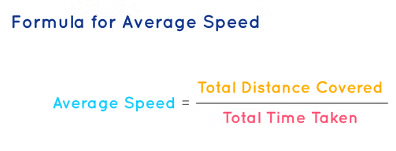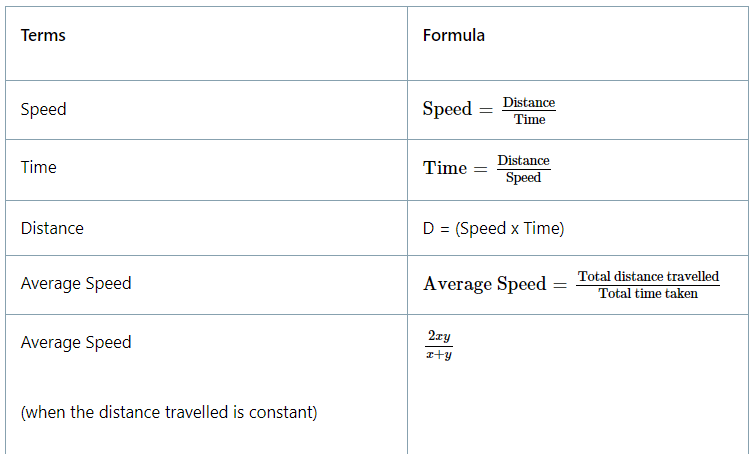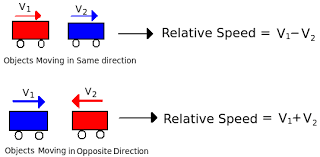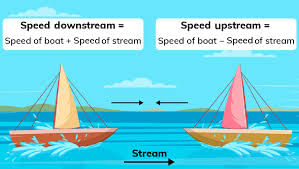Important Formulae: Time, Speed and Distance | CSAT Preparation - UPSC PDF Download
What are Time, Speed and Distance?
- Time: Time is an interval separating two events.
- Speed: Speed is the rate at which a particular distance is covered by an object in motion.
- Distance: Distance is the extent of space between two points.
Units of Speed Time and Distance
Each of the speed, distance and time can be represented in different units:

Example: If the distance is given in km and time in hr then as per the formula:
Speed = Distance/ Time; the unit of speed will become km/ hr.
Relationship Between Speed, Time and Distance
Now that we are well aware of the definition of speed, distance and time let us understand the relationship between them. Speed, Time and Distance are the three variables that represent the mathematical model of motion.
- Time is directly proportional to distance. It means that speed remains constant, if we have two vehicles moving two distances for two different time duration then the time is directly proportional to the distance.
- Speed is directly proportional to distance. It means that time remains constant if we have two vehicles moving two distances at two different speeds respectively.
- Speed is Inversely Proportional to time. It means that distance remains constant if we have two vehicles moving at two different speeds and taking times respectively.
Formula for calculating speed is:
This shows us how slow or fast a target moves. It represents the distance covered divided by the time needed to cover the distance.
Speed is directly proportional to the given distance and inversely proportional to the proposed time. Hence,
As the speed grows the time needed will decrease and vice versa.
Conversion of Speed, Time and Distance
(i) Conversion of Speed
To convert a given data from km/hour to m/sec, we multiply by 5/18: Similarly, to convert a given data m/sec to km/hour, we multiply by 18/5:
Similarly, to convert a given data m/sec to km/hour, we multiply by 18/5:
(ii) Conversion of Distance
In order to convert a bigger unit into a smaller unit, we multiply. For conversion of smaller unit into bigger unit, we divide. The conversions in distance as given as below:

Similarly, some other conversions are given below:
- 1 km/hr = 5/8 miles/hour
- 1 yard = 3 feet
- 1 kilometer= 1000 meters
- 1 mile= 1.609 kilometer
- 1 hour= 60 minutes= 3600 seconds
- 1 mile = 1760 yards
- 1 yard = 3 feet
- 1 mile = 5280 feet
(iii) Conversion of Time

(i) How to convert Hours to Minutes and vice versa?
The conversion of hours to minutes can be done by using a simple formula:
Number of minutes = (given no. of hours x 60) minutes
Similarly, conversion of minutes into hours = (Number of minutes/60) hours
(ii) How to convert Minutes to Seconds and vice versa?
The conversion of minutes to seconds can be done by formula given as follows:
Number of seconds = (given no. of minutes x 60) seconds
Similarly, conversion of seconds into minutes = (Number of seconds/60) minutes
Applications of Speed, Time and Distance
Some of the major applications of speed, time and distance are given below:
Average Speed: The average speed is determined by the formula = (Total distance travelled)/(Total time taken).

Case 1 – When the distance travelled is constant and two speed is given then:
where x and y are the two speeds at which the corresponding distance has been reached.
Case 2 – When the time taken is constant average speed is calculated by the formula:
where x and y are the two speeds at which we covered the distance for an identical time.
Example: An individual drives from one place to another at 40 km/hr and returns at 160 km/hr. If the complete time needed is 5 hours, then obtain the distance.
Solutions: Here the distance is fixed, so the time taken will be inversely proportional to the speed. The ratio of speed is given as 40:160, i.e. 1:4.
Therefore the ratio of time taken will be 4:1.
Total time is practised = 5 hours; therefore the time taken while travelling is 4 hours and returning is 1 hour.
Hence, distance = 40 x 4 = 160 km.
Case 3 - If the first part of any given distance is covered at a rate of v1 in time t1 and the second part of the distance is covered at a rate v2 in time t2 then the average speed is given by the formula:
Relative Speed
As the name suggests the idea is about the relative speed between two or more things. The basic concept of relative speed is that the speed gets combined in the case of objects moving in the opposite direction to one another and the speed gets subtracted for the case when objects are moving in an identical direction.
(i) For example, if two passenger trains are moving in the opposite direction with a speed of X km per hour and Y kilometre per hour respectively. Then their relative speed is given by the formula:
Relative speed = X + Y
(ii) On the other hand, if the two trains are travelling in the same direction with the speed of X km per hour and Y kilometre per hour respectively. Then their relative speed is given by the formula:
Relative speed = X - Y
For the first case time taken by the train in passing each other is given by the formula:
Relative speed = X + Y
For the second case, the time taken by the trains in crossing each other is given by the formula:
Relative speed = X -Y
Here L1, L2 are the lengths of the trains respectively.
Inverse Proportionality of Speed & Time: Speed is said to be inversely proportional to time when the distance is fixed. In mathematical format, S is inversely proportional to 1/T when D is constant. For such a case if the speeds are in the ratio m:n then the time taken will be in the ratio n:m.
There are two approaches to solving questions:
- Applying Inverse Proportionality
- Applying Constant Product Rule
Example: After moving 100km, a train meets with an accident and travels at (3/4)th of the normal speed and reaches 55 min late. Had the accident occurred 20 km further on it would have arrived 45 min delayed. Obtain the usual Speed?
Solutions: Applying Inverse Proportionality Method
Here there are 2 cases
Case 1: accident happens at 100 km
Case 2: accident happens at 120 km
The difference between the two incidents is only for the 20 km between 100 km and 120 km. The time difference of 10 minutes is just due to these 20 km.
In case 1, 20 km between 100 km and 120 km is covered at (3/4)th speed.
In case 2, 20 km between 100 km and 120 km is reached at the usual speed.
So the usual time “t” taken to cover 20 km, can be found as follows. 4/3 t – t = 10 mins = > t = 30 mins, d = 20 km
so the usual speed = 20/30min = 20/0.5 = 40 km/hr
Using Constant Product Rule Method: Let the actual time taken be equal to T.
There is a (1/4)th reduction in speed, this will result in a (1/3)rd increase in time taken as speed and time are inversely proportional to one another.
A 1/x increment in one of the parameters will result in a 1/(x+1) reduction in the other parameter if the parameters are inversely proportional.
The delay due to this reduction is 10 minutes
Thus 1/3 T= 10 and T=30 minutes or 0.5 hour
Also, Distance = 20 km
Thus Speed = 40 kmph
Meeting Point Question
If two individuals start from locations P and Q and travel towards each other, meeting at a point X, then the total distance they have collectively covered at that instant will be the entire distance PQ.
The time taken by both of them to meet is the same. Since the time is constant, the distances they individually cover, i.e. PX and QX, will be in the ratio of their speeds. Suppose the distance between P and Q is d.
- At their first meeting, the total distance covered together is d.
- At their second meeting, the total distance covered together is 3d.
- At their third meeting, the total distance covered together is 5d.
This pattern continues, so at the nᵗʰ meeting, the total distance covered will be (2n − 1)·d.
Example: Ankit and Arnav have to travel from Delhi to Hyderabad in their respective vehicles. Ankit is driving at 80 kmph while Arnav is operating at 120 kmph. Obtain the time taken by Arnav to reach Hyderabad if Ankit takes 9 hrs.
Solutions: As we can recognise that the distance covered is fixed in both cases, the time taken will be inversely proportional to the speed. In the given question, the speed of Ankit and Arnav is in a ratio of 80: 120 or 2:3.
Therefore the ratio of the time taken by Ankit to that taken by Arnav will be in the ratio 3:2. Hence if Ankit takes 9 hrs, Arnav will take 6 hrs.
Speed, Time and Distance Formulas


Some additional formulas of speed, distance and time are:
- If the ratio of the speeds of P and Q is p: q, then the ratio of the times used by them to reach the same distance is 1/p:1/q or q: p.
- If two individuals or automobiles or trains start at the exact time in the opposing direction from two points say A and B and after crossing each other they take time a and b respectively to finish the journey then the speed ratio is provided by the formula:

- If two individuals with two different speeds x and y cover the same distance and travel in opposite directions. Where the total time is given and distance is asked then the formula is:

Types of Questions from Speed, Time and Distance
There are some specific types of questions from Speed, time and distance that usually come in exams. Some of the important types of questions from speed, distance and time are as follows:
(a) Problems Related to Trains
Please note that, in the case of the train problems, the distance to be covered when crossing an object is equal to, Distance to be covered = Length of train + Length of object.

Remember that, in case the object under consideration is a pole or a person or a point, we can consider them to be point objects with zero length. It means that we will not consider the lengths of these objects. However, if the object under consideration is a platform (non-point object), then its length will be added to the formula of the distance to be covered.
(b) Boats and Streams
In such problems, boats travel either in the direction of stream or in the opposite direction of stream. The direction of boat along the stream is called downstream and the direction of boat against the stream is called upstream.

If the speed of a boat in still water is u km/hr and the speed of the stream is v km/hr, then:
(1) Speed downstream = (u + v) km/hr
(2) Speed upstream = (u – v) km/hr
Tips and Tricks
We can find different tips and tricks below for solving the questions based on speed, time and distance.
Tip 1: Relative Speed
- Relative speed is the speed of one moving body with respect to another.
- Same direction: Relative speed = difference of their speeds (always positive).
- Opposite direction: Relative speed = sum of their speeds.
Tip 2: Average Speed
Tip 3: When a train passes a moving man or point object:
- Distance travelled by the train = length of the train.
- Relative speed depends on direction:
1. Same direction → Relative speed = difference of their speeds.
2. Opposite direction → Relative speed = sum of their speeds.
Tip 4: When a train passes a platform (or any long stationary object):
Distance travelled = length of train + length of platform/object.
Tip 5: When a train passes a stationary man or a point object:
Distance travelled = length of the train.
Solved Examples of Speed, Time and Distance
Example 1: The speed of three cars are in the ratio 5 : 4 : 6. The ratio between the time taken by them to travel the same distance is ________ .
Solution: Since speed and time follow inverse relation,Speed = Distance / Time
Ratio of time taken = 1/5 : 1/4 : 1/6 = 12 : 15 : 10
Example 2: A boat takes 40 minutes to travel 20 km downstream. If the speed of the stream is 2.5 km/hr, how much more time will it take to return back?
Solution: Time taken downstream = 40 min = 40/60 = 2/3 hrs. Downstream speed = 20/ (2/3) = 30 km/hr.
As we know, speed of stream = 1/2 × (Downstream speed – Upstream speed)
⇒ Upstream speed = 30 – 2 × 2.5 = 30 – 5 = 25 km/hr.
Time taken to return back = 20/25 = 0.8 hrs. = 0.8 × 60 = 48 min.
∴ The boat will take = 48 – 40 = 8 min. more to return back.
Example 3: Two trains are moving in the same direction at speeds of 43 km/h and 51 km/h respectively. The time taken by the faster train to cross a man sitting in the slower train is 72 seconds. What is the length (in metres) of the faster train?
Solution: Given: The speed of 2 trains = 43 km/hr and 51 km/hr Relative velocity of both trains = (51 – 43) km/hr = 8 km/hr Relative velocity in m/s = 8 × (5/18) m/s
⇒ Distance covered by the train in 72 sec = 8 × (5/18) × 72 = 160
Hence, the length of faster train = 160 m
|
205 videos|264 docs|136 tests
|
FAQs on Important Formulae: Time, Speed and Distance - CSAT Preparation - UPSC
| 1. What are the basic concepts of Speed, Time, and Distance in mathematics? |  |
| 2. How are Speed, Time, and Distance related to each other? |  |
| 3. How can Speed, Time, and Distance be converted into different units of measurement? |  |
| 4. What are some practical applications of Speed, Time, and Distance in real life? |  |
| 5. What are some important formulas related to Speed, Time, and Distance that are frequently used in competitive exams like CAT? |  |

















